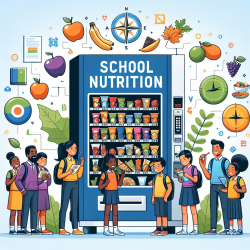Introduction
In the bustling world of secondary schools, vending machines often stand as beacons of convenience, offering quick snacks and drinks to busy students. However, the contents of these machines can have significant implications for student health, especially when they do not comply with established nutrition policies. The recent study, "Secondary School Nutrition Policy Compliance in Ontario and Alberta, Canada: A Follow-Up Study Examining Vending Machine Data from the COMPASS Study," sheds light on the current state of vending machine compliance with provincial nutrition policies in Ontario and Alberta. Let's explore how practitioners can leverage these findings to enhance their practice and encourage healthier school environments.
Understanding the Findings
The study reveals that despite the existence of mandatory nutrition policies in Ontario and recommended guidelines in Alberta, many secondary schools remain non-compliant. Between 2015 and 2019, the majority of vending machines in these schools continued to offer products that did not meet the nutritional standards outlined in the policies. While Ontario saw a slight improvement in drink machine compliance, snack machines largely remained non-compliant. Alberta's voluntary guidelines resulted in even lower compliance rates.
Implications for Practitioners
For practitioners working in the field of education and nutrition, these findings underscore the need for a more robust approach to policy implementation and compliance monitoring. Here are some actionable steps practitioners can take:
- Advocate for Mandatory Policies: Encourage the adoption of mandatory nutrition policies in regions where they are currently voluntary, such as Alberta. Mandatory policies provide a stronger framework for ensuring compliance.
- Provide Training and Support: Offer training sessions for school staff on how to implement and monitor nutrition policies effectively. This can include workshops on reading nutritional labels and understanding policy requirements.
- Engage Stakeholders: Involve students, parents, and community members in the conversation about school nutrition. Their input can help tailor policies to better meet the needs of the school community.
- Monitor and Evaluate: Establish regular monitoring and evaluation processes to assess compliance and identify areas for improvement. Use tools like the Co-SEA to gather objective data on vending machine contents.
Encouraging Further Research
The study also highlights the need for further research into the barriers to policy compliance and the effectiveness of different implementation strategies. Practitioners can contribute to this body of research by:
- Conducting Case Studies: Document and share successful case studies of schools that have achieved high compliance rates. These can serve as models for other schools.
- Exploring Student Behavior: Investigate how changes in vending machine offerings impact student purchasing behavior and overall dietary habits.
- Collaborating with Researchers: Partner with academic institutions to conduct longitudinal studies that track the impact of nutrition policies over time.
Conclusion
School nutrition policies are crucial for promoting healthy eating habits among students. However, compliance remains a challenge. By taking proactive steps to advocate for stronger policies, provide training, engage stakeholders, and conduct further research, practitioners can play a pivotal role in creating healthier school environments. For those interested in delving deeper into the research, the original study offers valuable insights and data.
To read the original research paper, please follow this link: Secondary School Nutrition Policy Compliance in Ontario and Alberta, Canada: A Follow-Up Study Examining Vending Machine Data from the COMPASS Study.










